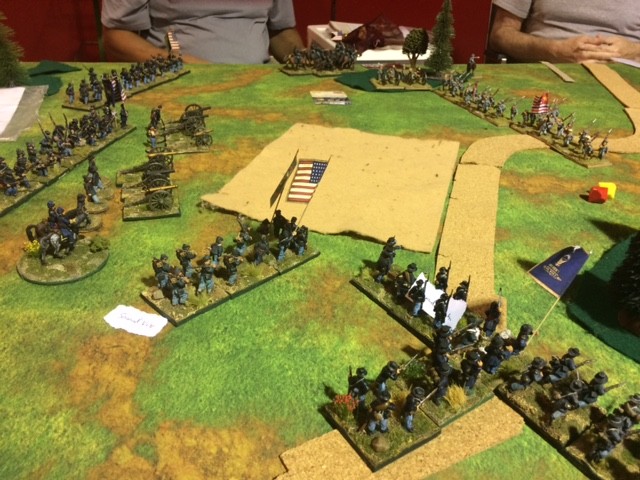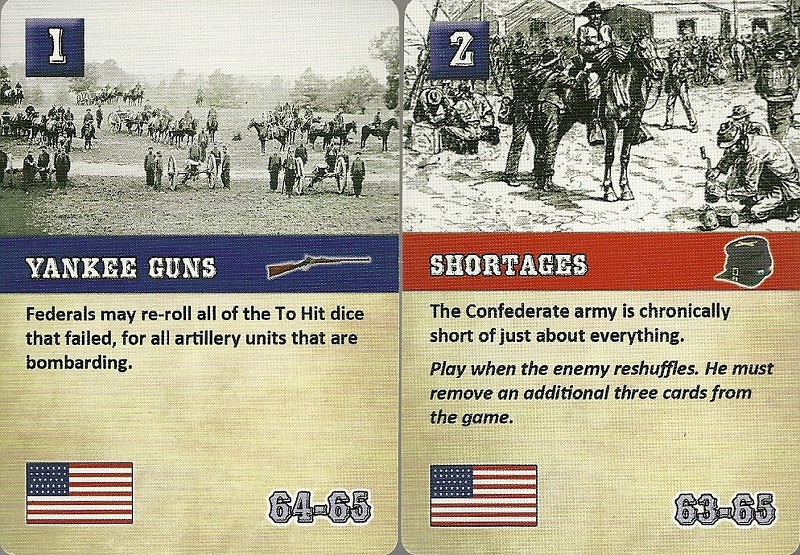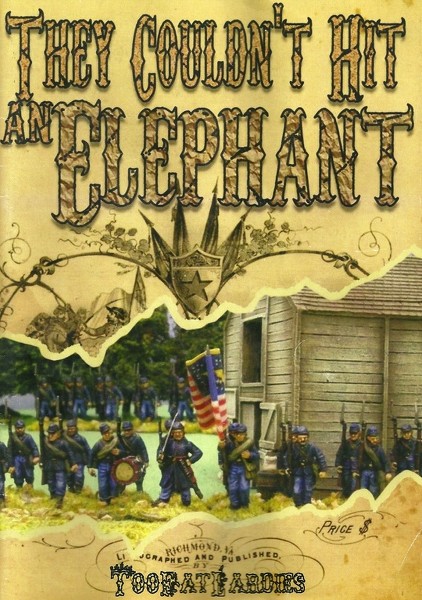It was also a chance to give James this piece for his Napoleonics collection, a 28mm Front Rank figure, Archduke Charles, for James' Austrian force. Seeing as James usually plays Sharp Practice, the Archduke may qualify as the biggest of Big Men. He certainly has a big hat! He's painted using the Foundry tritone system. I don't paint or collect 28mm Napoleonics, but Front Rank's figures may yet tempt me.
Saturday, August 17, 2024
EX THUNDERING DICE 2-24: A Wargames Weekend
It was also a chance to give James this piece for his Napoleonics collection, a 28mm Front Rank figure, Archduke Charles, for James' Austrian force. Seeing as James usually plays Sharp Practice, the Archduke may qualify as the biggest of Big Men. He certainly has a big hat! He's painted using the Foundry tritone system. I don't paint or collect 28mm Napoleonics, but Front Rank's figures may yet tempt me.
Saturday, November 2, 2019
Picking Up Pickett
I’ve set up an American Civil War battle because I wanted to try the Pickett’s Charge rules from Too Fat Lardies|Reisswitz Press. I’ve chosen the terrain randomly, using the Terrain cards included in the Longsreet/Sam Mustafa rules and assigning four Terrain Cards randomly per side.
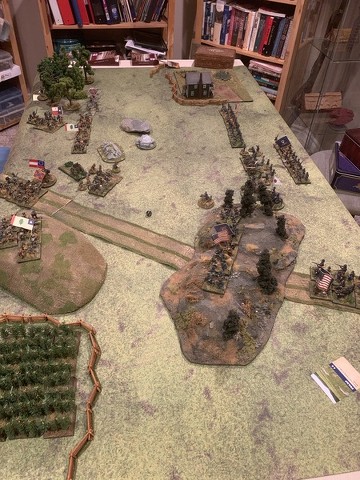
Chosing a side randomly, the Confederates have to attack. The key terrain feature is the ridge held by the Union (top right), so that is the Confederate objective.
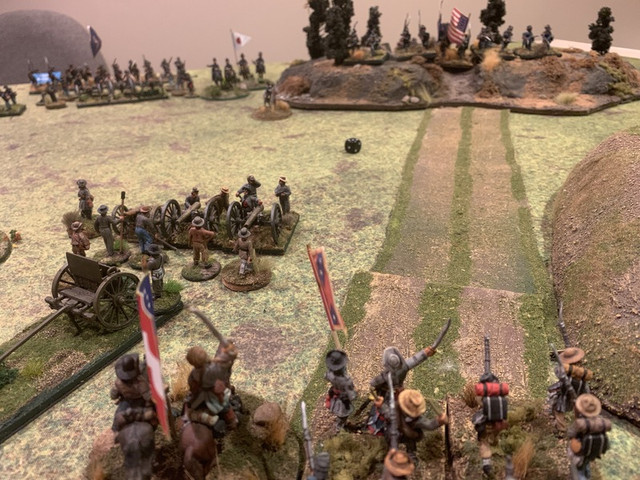
The Union are defending with one brigade of four regiments, all of average size and training, and one battery, and deployed first. The Confederates enter the table wth five regiments, also average size and training, and one battery. Pickett’s Charge is written for divisional or larger size battles, and the heart of the rules have to do with the management of brigades. I’ll try that once I get the basic mechanics sorted.
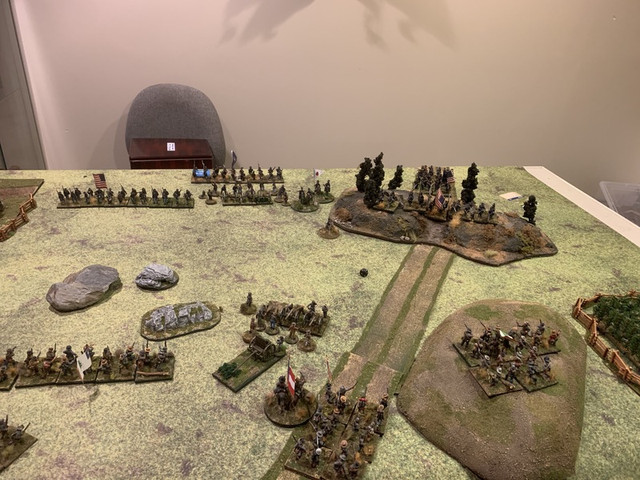
Confederate general Ginger Purrsival inspects his brigade.
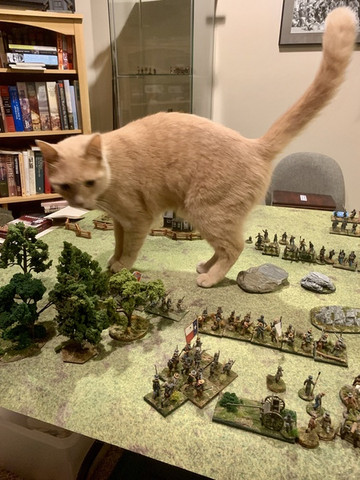
“I need more time and more men. I could march to his flank, and get around him. Then I could bat him around like a mouse and eat him."
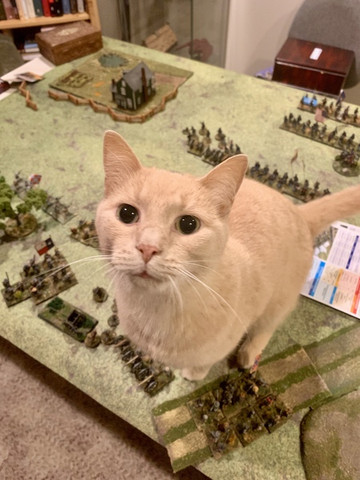
How will the Confederates fare? I hope to show you more soon.
Blessings to your dice rolls!
Tuesday, October 4, 2016
Awaiting Pickett's Charge, Or, Do I Need Another Set of ACW Rules?
A lot of this going on at my games club lately. Would it be better with another set of rules?
I noted with interest this recent interview by Sidney Roundwood, one of the Too Fat Lardies braintrust, with Dave Brown, the designer of the forthcoming Pickett's Charge rules.
PC, as I will hence refer to it, is being published by TFL under their new imprint, Reisswitz Press. As TFL's Richard Clarke explains it, Reisswitz will allow TFL to support the work of other rules writers who share what one might call the Lardies philosophy of ''a large dollop of Clausewitzian friction and an emphasis on command decisions ''.
While I am exited by this news and always happy to support one of Big Rich's projects, I suppose a fair question would be, ''Does the hobby really need another set of ACW rules? Now I am not a tyro in this genre of gaming, but I'm not exactly a grognard either. I started 25 years ago playing Johnny Reb II and found it somewhat maddening. One worked through long lists of modifiers, which gave the impression of realism, but units could charge and strike like summer lightning, in a way that seemed profoundly unrealistic because it didn't seem to reflect any command and control issues or any tactical limitations of the period. I vividly recall having my mouth drop open when I closed in on an enemy formation from its rear, only to see the unit about-face and charge me before I could get a volley off. I suppose one could pivot a tank like that, but not a line of 600 men in the midst of a battle.
Since then I have dabbled in Black Powder and find it somewhat generic. The activation rules are a attempt to model friction, but they seem essentially a random element. Readers of this blog will know that for the past two years, Sam Mustafa's Longstreet has been my ACW drink of choice. I will go to great lengths to defend these rules - they are simple, they force difficult decisions on players at every step of the way, and they capture the narrative arc of the war, so that there is an appreciable difference between a fight in 1861 and one in 1865. In the campaign game we are currently playing at the club, I can assure you that it is more fun to be late war Union than it is to be the early war Union, as the faces of our Reb opponents get grimmer with each battle!
There are other established ACW rules out there which I don't know at all. Fire and Fury is probably the most well known rules set I have never played, which is odd, because Regimental F&F is probably ideally suited to my 28mm collection. I noted with interest the late John Hill's Across A Deadly Field rules, published by Osprey last year, but felt committed to Longstreet and didn't buy it. Beneath these two titles lurks a veritable iceberg of other ACW rules.
Briefly, TCHAE shows the influence of TFL's popular WW2 rules, I Ain't Been Shot, Mum (IABSM), in that it uses a system of blinds to bring hidden units into the battle, and uses a card activation system to determine the order in which commanders are activated. Once a commander is activated, he gets a number of commands, or pips, determined by an average dice with some plus or minus mods depending on how skilled or wretched the commander is. Commanders use their pips to achieve tactical effects: moving and changing the formation of units, rallying them, etc. Also, the IABSM influence is seen in the random termination of each turn when the Coffee Card (shades of the Tea Break card) is drawn. Units that have been given pips to reserve their fire can shoot on the Coffee Card.
Not everyone liked TCHAE. One review noted the occasional ambiguities of the rules and some frustration with the TFL philosophy that the rules are as much a toolbox as they are a complete system.
Last week I sent Richard Clarke a message on Twitter, asking him if he could say how TCHAE differed from PC, and he was honest enough to say that it was years since he had played Elephant and didn't remember much about it. I suppose I shouldn't have been surprised by this answer, since rules publishers need to publish new product to stay in business, and hopefully each iteration brings improvements from lessons learned. In terms of TFL's evolution, one hopes that PC is to Elephant what Chain of Command is to IABSM, a natural development of concepts and mechanisms.
What I see in PC from the Roundwood interview is a more nuanced approach to command and control than the pip system. I like the idea that brigade commanders see their degree of control start to degrade as the battle wears down their troops. I also like the idea of the commander sending staff officers to try to keep units on task. I suspect that PC has jettisoned the idea of blinds, which I never felt worked very well for the ACW in the scale (28mm) that I play it in, though perhaps in 6mm.
So, while I am curious to get my mitts on PC, I am going use this Thanksgiving Weekend to put some ACW figures on the table and see how TCHAE plays after five or six years.
In the meantime, blessings to your die rolls!
MP
Tuesday, April 26, 2016
An Epic Night of Longstreet
Four of us played a game of Longstreet at the wargames club last night. It is quite a dark space, so I had to play with the exposure on these photos.
We used Len’s Cigar Box Battle Mat, which looked quite spiffy. We put some styrofoam hills under the mat to create some elevations. Stephen and I took the Union, while Len and Bruce took the Corn Fed Rats. We were both using the starting forces for a Longstreet Grand Campaign set in 1861
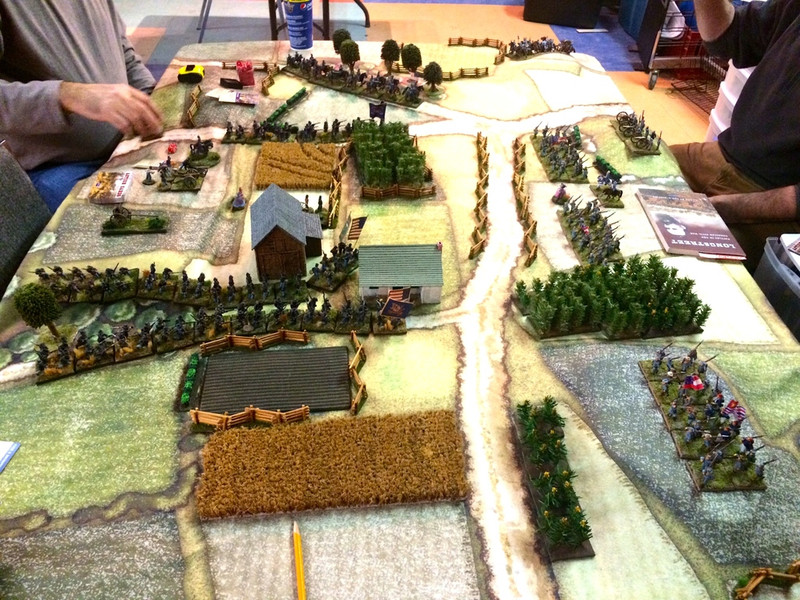
We are the attackers. Our Union regiments go forward in column. At the start of a Longstreet campaign, 10 stand units look quite impressive.
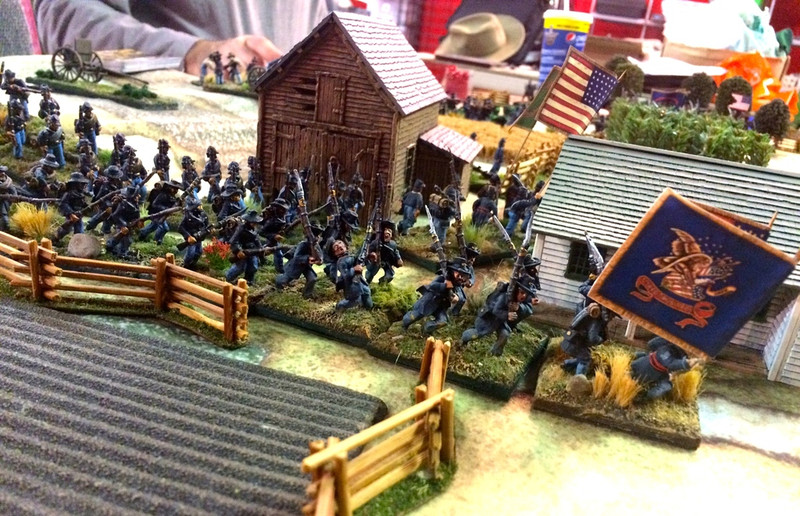
One of Len’s regiments awaits the onslaught. All of Len’s units are Sash and Sabre figures, and looked quite fine.
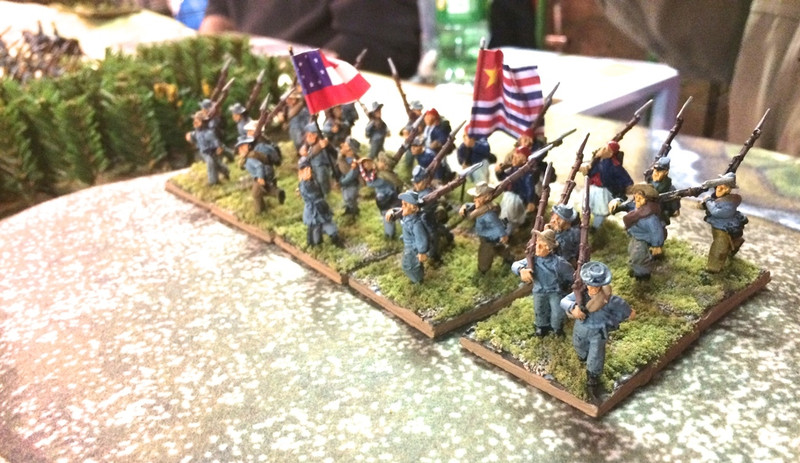
The view from my position. Two young ladies watch the battle in the foreground, obligingly serving as Objective Markers. Both sides had artillery mounted on hills, but we found that the rule about Shooting Over Friendlies (Longstreet p. 41), which requires that there be 6BW or more between the artillery and the friendlies, and at least another 6BW between the friendlies and the target, meant that it was very for the artillery to support the infantry.
The building in the foreground is one of Len’s - it looks very good. Not sure what make it is.

In the centre you can see that I pushed one of my artillery bases forward to engage the enemy with canister, but they were shot down before they could get off a round. I didn’t regret the move, as it took some pressure off the Irish moving up in column to the right of the gun section. in retrospect, though it’s not clear in the rule (Longstreet p. 20) on artillery formations, this may have been an illegal move, as I am not aure that one can break up artillery formations.
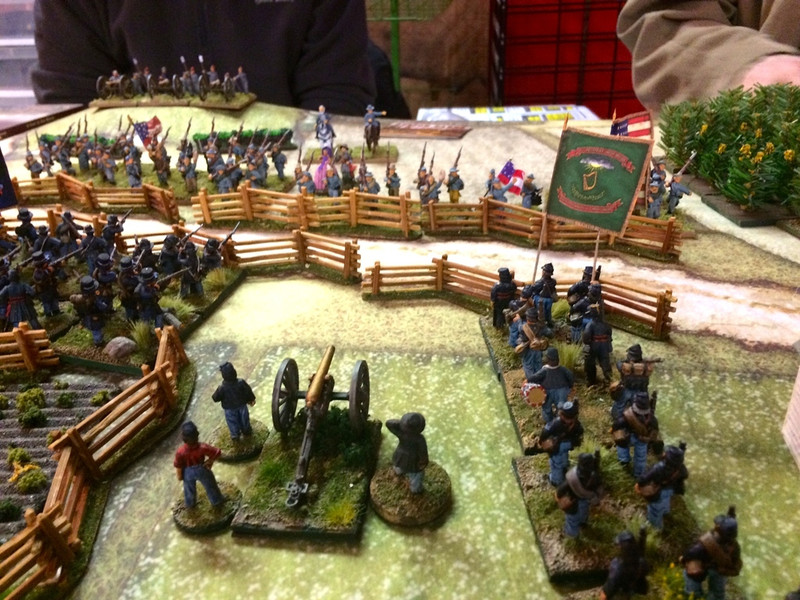
It all comes down to the big face-off. I moved my two surviving guns to the right, where they could engage Len’s infantry on the hill on his left wing. He saw my clever move, and brought his fellows down to shelter from the guns behind my black hats.
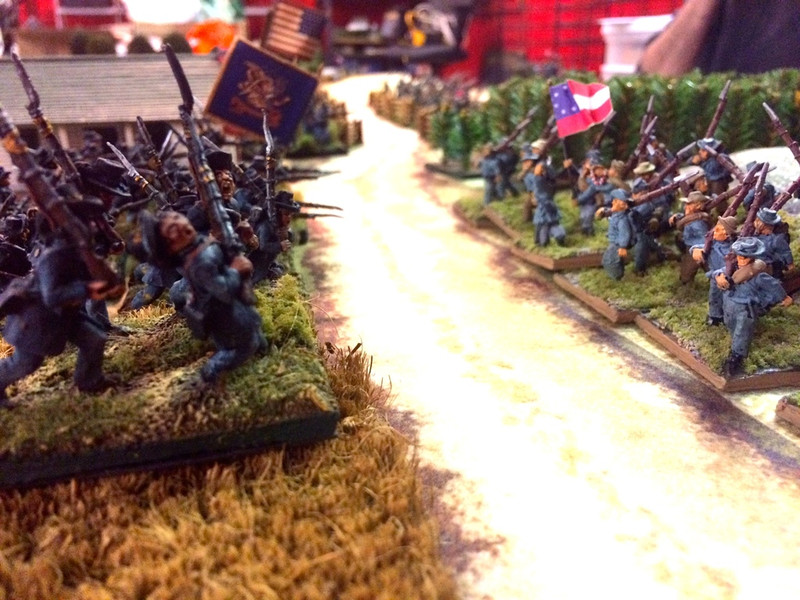
The big climax. Stephen and I played the Charge Bayonets card (I think that’s what it was called) which allows units to shoot and then charge in the same turn.
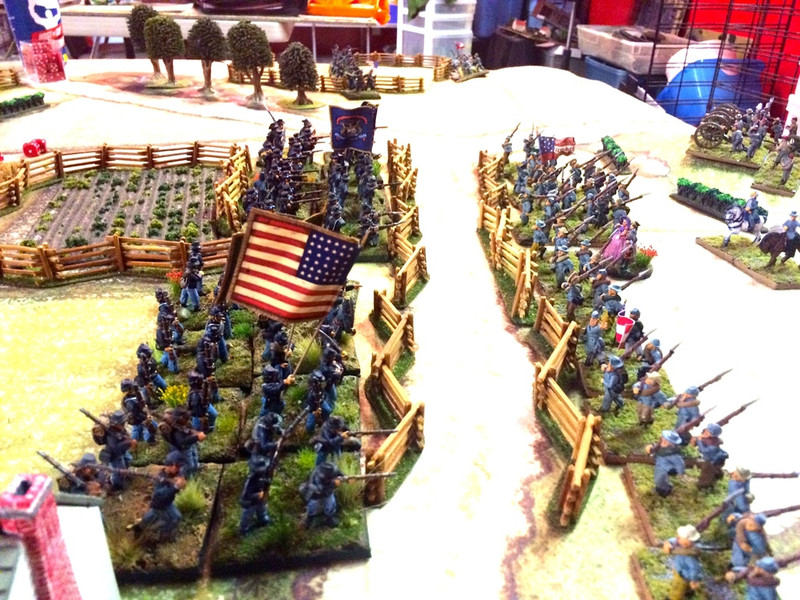
All four of our units charged, even the dismounted cavalry which don’t do as well in Combat as infantry do. We split the honours, winning two of the battles on our right and losing two on the left. We had an advantage, since all of the units started out as Eager, and Eager units do better on the attack than the defence. However, with over thirty bases in total charging, that qualified us for three Epic Points, which means that we totally won the battle.
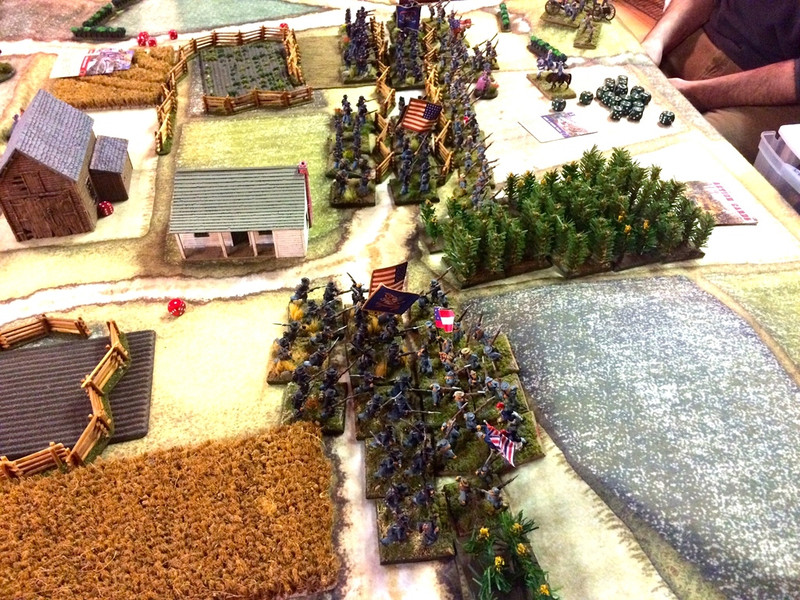
We had time to run the post-battle process. All four of our units kept their élan as Eager, while two of the rebel infantry units fell from Eager to Seasoned as a result of casualties. It must have been because they got roughly handled in our Epic charge. We were doing well until Stephen rolled for Reduction. Out of nine dice for one of our nine-stand infantry regiments, Stephen rolled five “1”s, which meant that we lost five stands from disease. Wow, the brigade shouldn’t have stopped at that IHop on the way home, the food poisoning was brutal. Should have listened to the Adjutant, he thought that buffet looked dodgy.
We did ok one our Campaign cards, gaining 2 artillery stands (Light Rifles), a company of Sharpshooters for one infantry regiment, and raising our hardest hit infantry unit to Veteran status.
Here’s the Union force after the post-battle phase:
7 stands Cavalry, Eager Recruits
4 stands Infantry, Eager Veterans (w Sharpshooter company)
7 stand infantry, Eager Recruits
8 stands Infantry, Eager Recruits
1 artillery formation: 2 stands Light Rifles, 1 artillery formation
1 artillery formation: 1 stand howitzer, 1 stand 6 pdr smoothbore
Replacements: 6 stands infantry, Eager Recruits
Hopefully next week this force can seek it’s next battle, in 1862.
Blessings to your die rolls!
MP
Wednesday, October 28, 2015
Another Longstreet Report
Here’s another Longstreet AAR from the weekend. The last three posts here were about a solo game, but on Saturday night Stephen from the games club and his friend Ray came over to the house and we actually christened the games room with a H2H game. It’s a small room, so it was a little awkward the three of us shuffling around the table trying not to touch each other. Figures from my collection.
I’m ambivalent about river crossing scenarios, since they produce games based on attrition rather than maneuver., but that’s what we rolled from the list of scenarios in the Longstreet rule book: #10, River Crossing. We rolled for the year and got 1861, so since the card deck favours the CSA in the early war, we gave the Union more troops and more guns and made them attack. Stephen drew the Union straw. Ray had four fords to defend (marked with sand in the photo below), two on his left where the stream makes a 90 degree turn, and one on either side of his centre. Other than the fords, the stream is impassable. Ray decided to cover all of the fords, living one regiment as a reserve in the woods on his left flank.
Stephen’s Union setup is on the far edge of the board, within the boundary area defined by the red dice. Since he has a nasty chunk of woods bisecting a third of his deployment area, he decided to use it to his advantage by screening the approach of three of his attacking regiments from the two sections of Napoleons that Ray placed in the centre of his line.
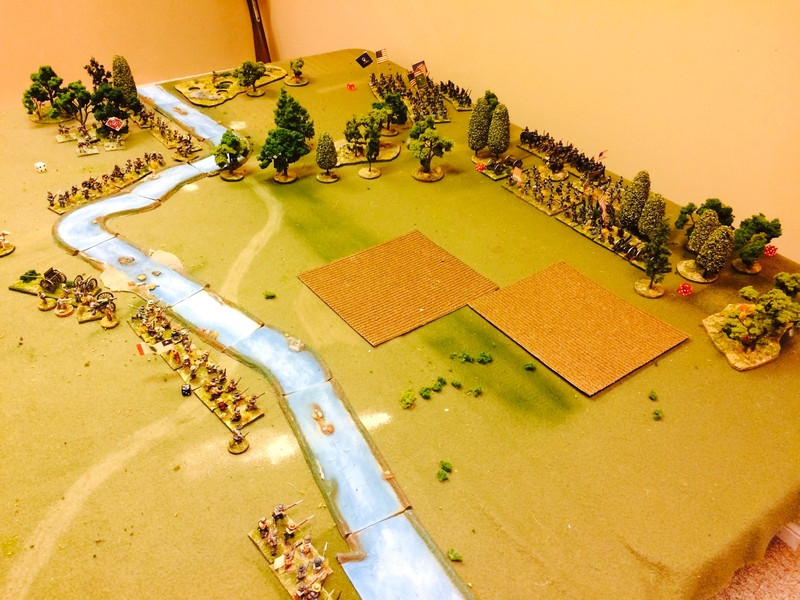
Stephen approaches everywhere, without waiting to use his four rifled guns to bombard the rebs first.
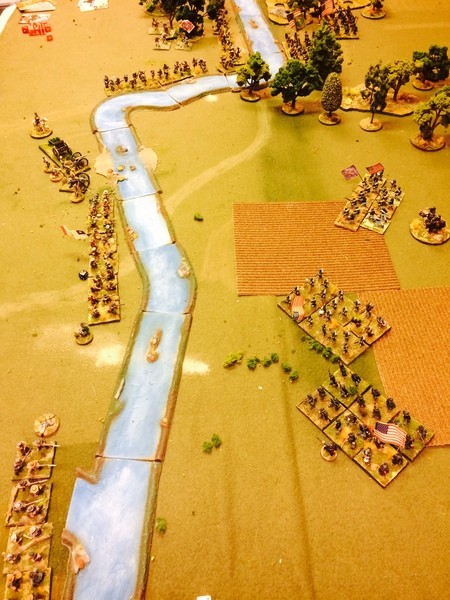
Since one of his four fords isn’t being threatened, Ray marches forward, not caring for that gun on his left flank. Stephen rushes his cavalry reserve over to check them.
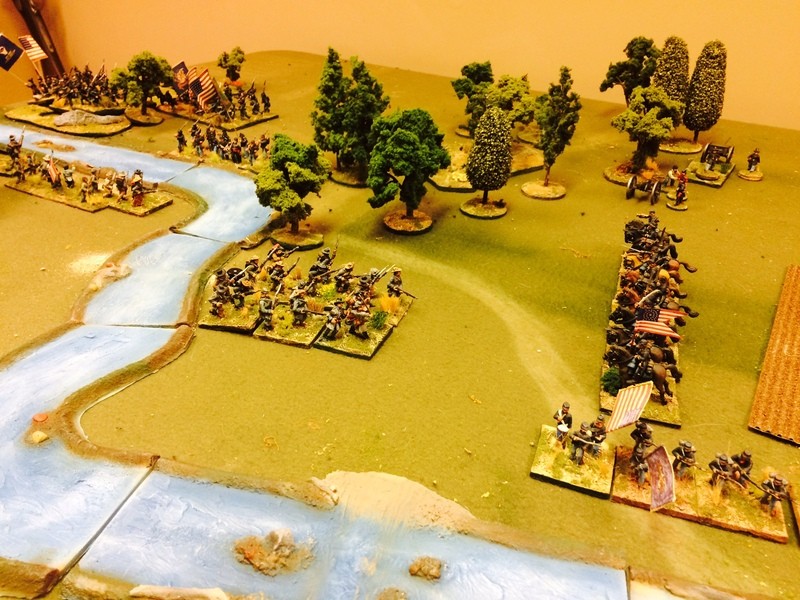
Come on men, forward!
But sir, my hands are empty because Mike hasn’t ordered me a flag yet!
Shut up!
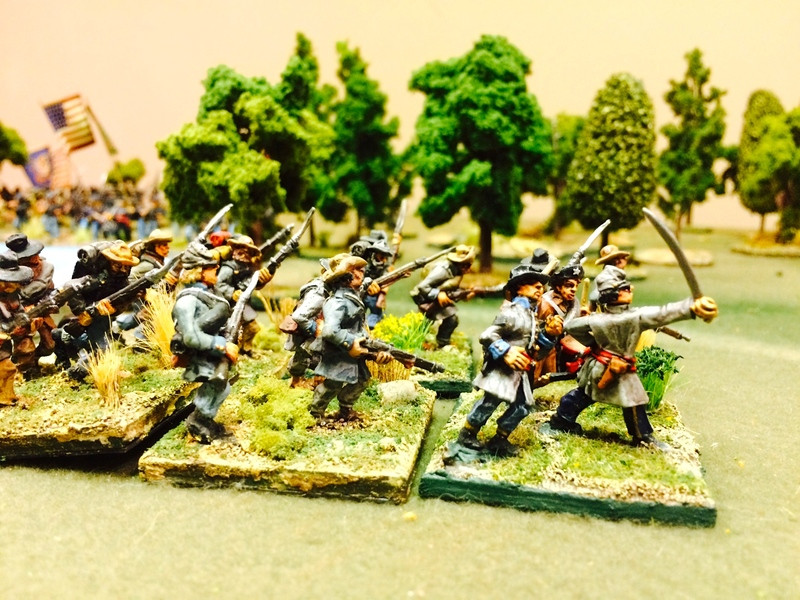
OK, boys, let’s go into line.

Stephen has two problems. First, win the firefight. Second, he can’t cross the ford in line, he has to change formation in line and charge at two significant disadvantages (fighting in difficult terrain and only fighting with the first two ranks of his column).
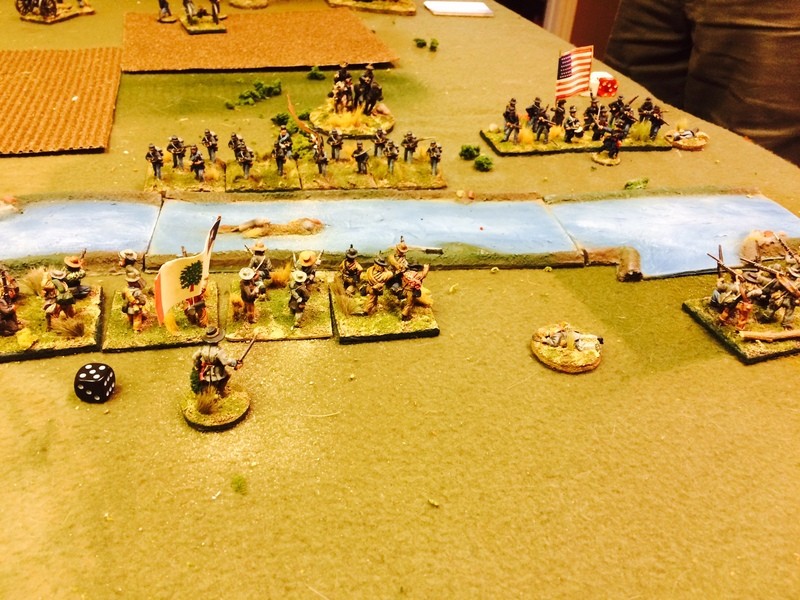
But numbers tell, the feb defenders on the right melt away after a flurry of cards and firing and Stephen is able to cross one regiment as the clock runs out. Here my ancient Minifigs figures get their moment of glory.

We had a good fight, and a good game. It was too easy to teach the basics of the game in ten minutes, and despite never having played it before, Ray and Stephen had picked up the subtleties of the card play. Several over chaps in the local club have the rules and their own figures, and I hope that at some point we can pool our figures. With four decks of cards we could have a very interesting multiplayer game.
Blessings to your die rolls!
MP+
Sunday, October 25, 2015
Longstreet, Ebeneezer Seizure Part Three
There was a lot of Longstreet this weekend. Before some friends came by for a game Saturday night, I had a chance to finish the battle I’ve been describing here and here.
Below, CSA General Pinckney tries to consolidate his position against the advancing enemy. The 14th Arkansas is ordered to hold and buy time and so volleys into the advancing 33rd and 31st Wisconsin.
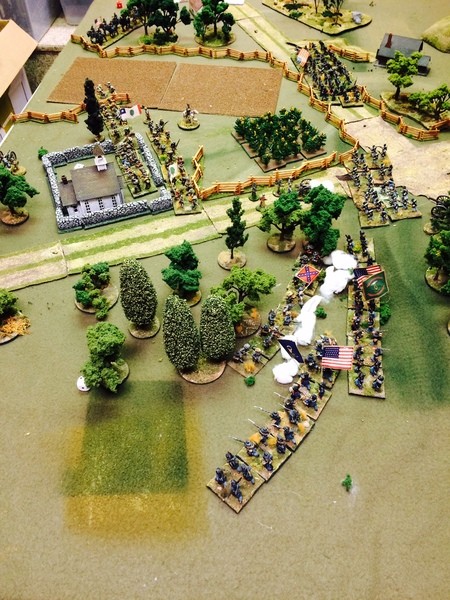
But does no damage and is charged by both the Union regiments. With over ten bases charging, that earns Col. Schotz an Epic Point.
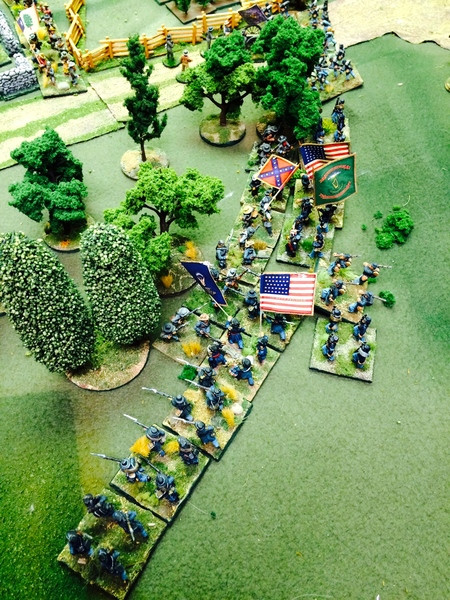
In the same Charge Phase, the 11th Ohio charges and overruns the isolated Napoleon section of the Little Rock Artillery. Unsupported guns have little chance of winning hand to hand combat against infantry in Longstreet.
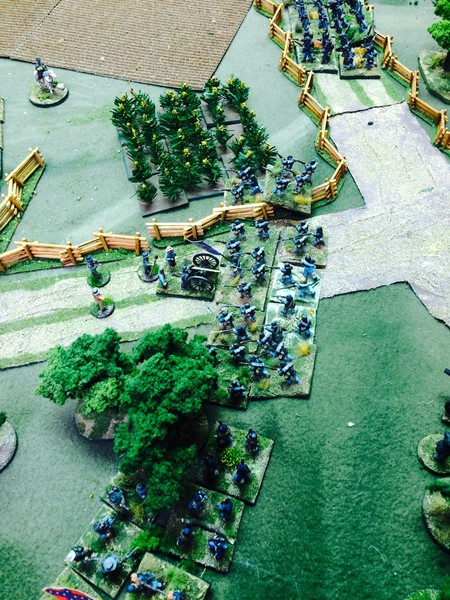
“Git along, secesh!” Sullen prisoners are herded to the year. These are some of my favourite figures, Perry sculpts from the Wargames Foundry range.
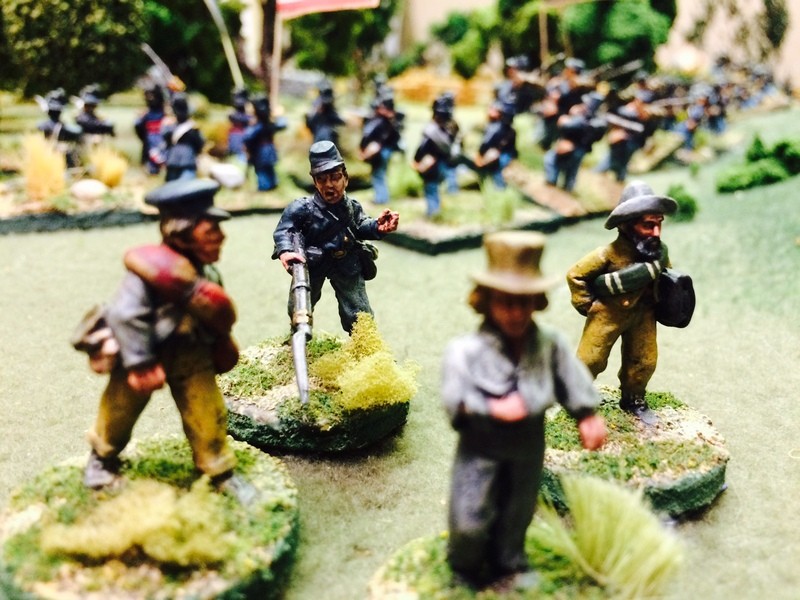
Confederate turn. 14th Arkansas on the lower left has been thrown out of the woods but reforms and anchors its left flank on the 42nd Mississippi which has by now mostly completed its transit from the Rebel left wing.
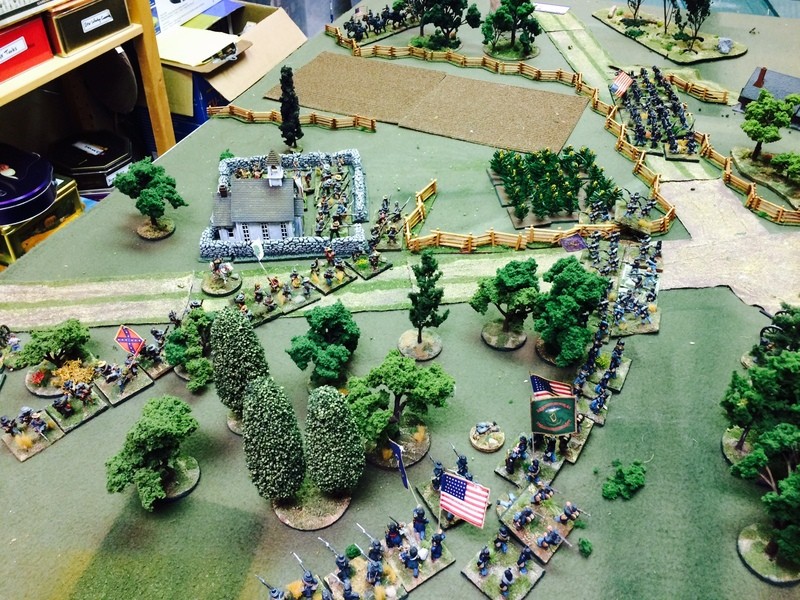
The 39th Mississippi has completed its fallback and now adopts a line formation conforming to the stone fence. I gave them a Hero, Major Thaddeus Lamont, who exhorts his men to hold firm with some vigorous hat waving. Heroes in Longstreet give extra dice to units in hand to hand combat.
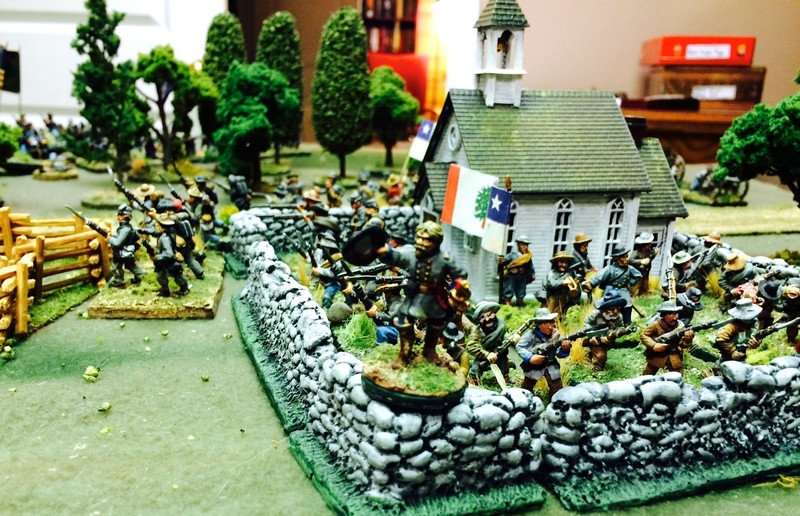
Because of the Union charges, there hasn’t been a lot of opportunity for the rest of Schotz’s brigade to move. Now the rookies of the 23rd Michigan advance on the church. At the bottom right, the 5th Kansas rides up to the fence line and ponders what to do.
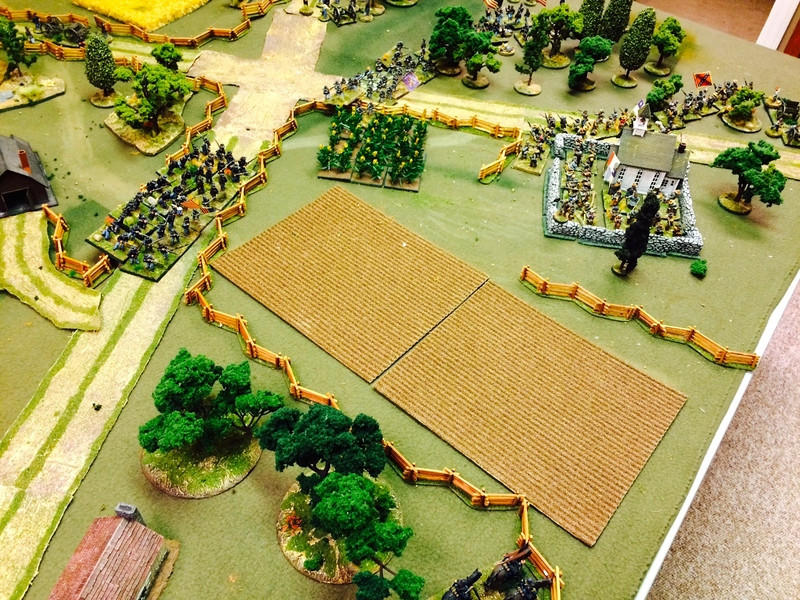
Rebel position is firming up. The 14th Arkansas and 42nd Mississippi guard the right flank of Ebeneezer Church, while the surviving section of the Little Rock Arty rides into position on the right of the 14th (note again the invisible horses of the limber team).
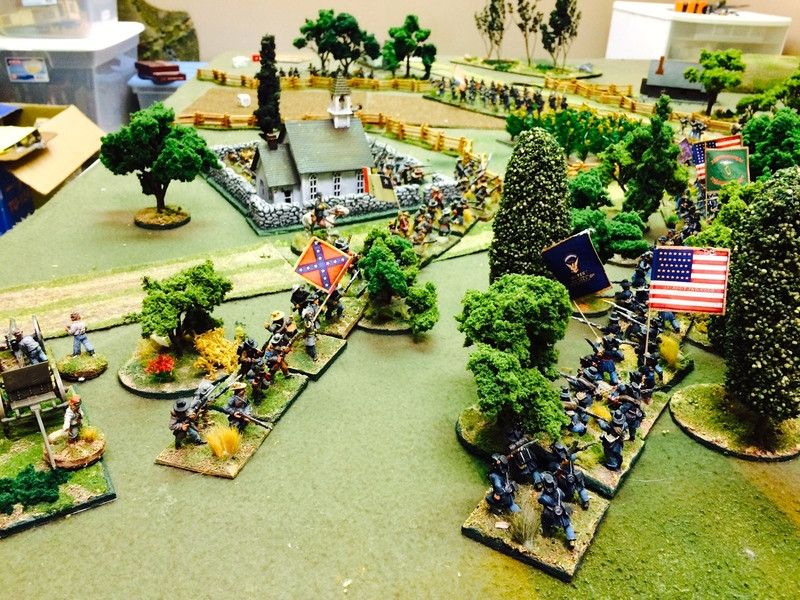
5th Kansas cavalry dismount at the fence line and look menacing along with the advancing Michiganders.
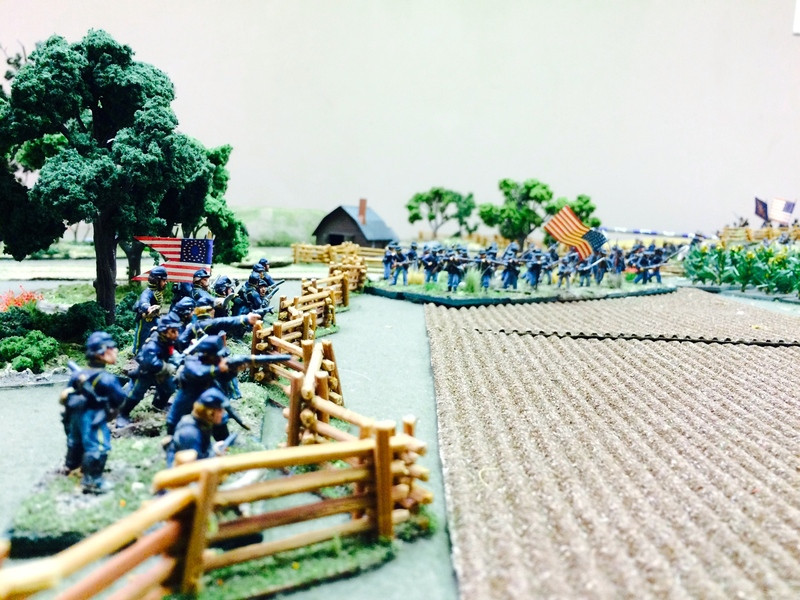
But the sturdy defenders of Ebeenezer Church do not appear to be fazed.
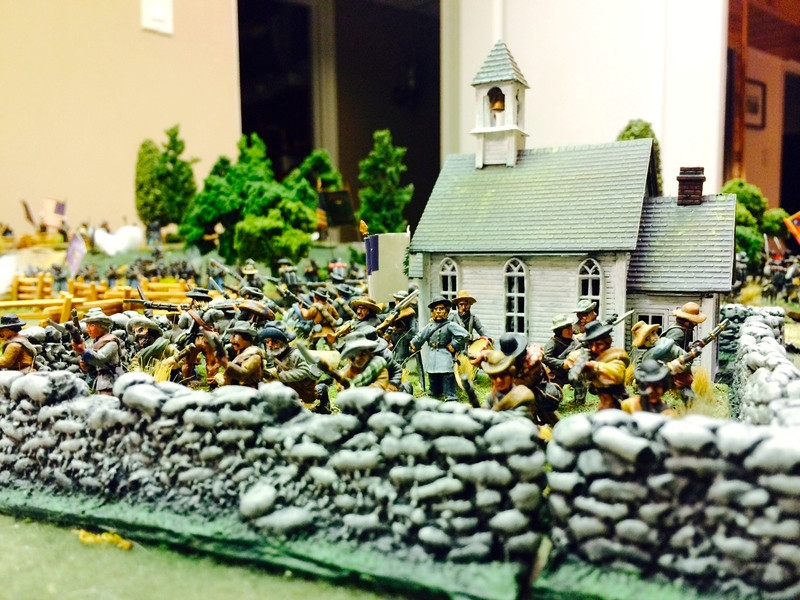
Little Rock gunners open up in support of the Arkansans and slowly the 31st Wisconsin is being whittled down.
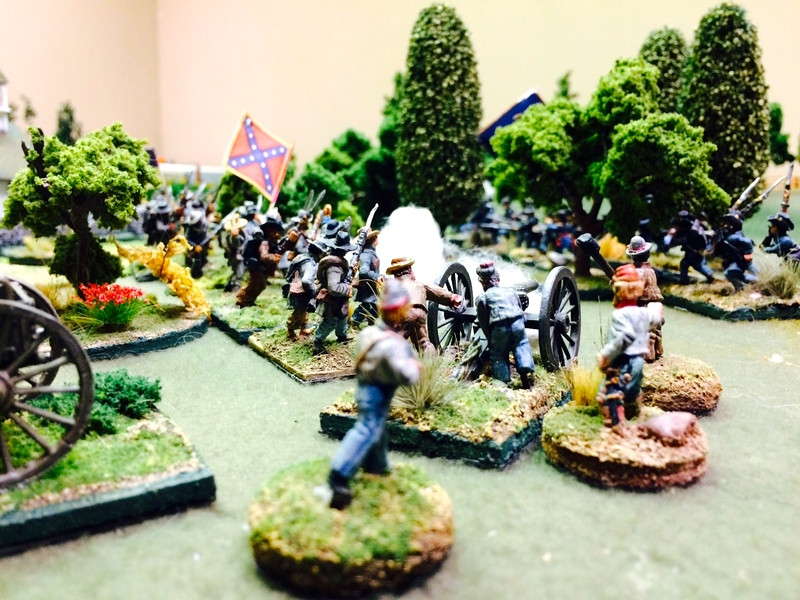
Schotz has a card that allows units to fire and then charge, which they can’t normally do. The 31st on the left and the 33rd on the right fire, but since they are shooting through woods it is Skirmish fire and not terribly effective.
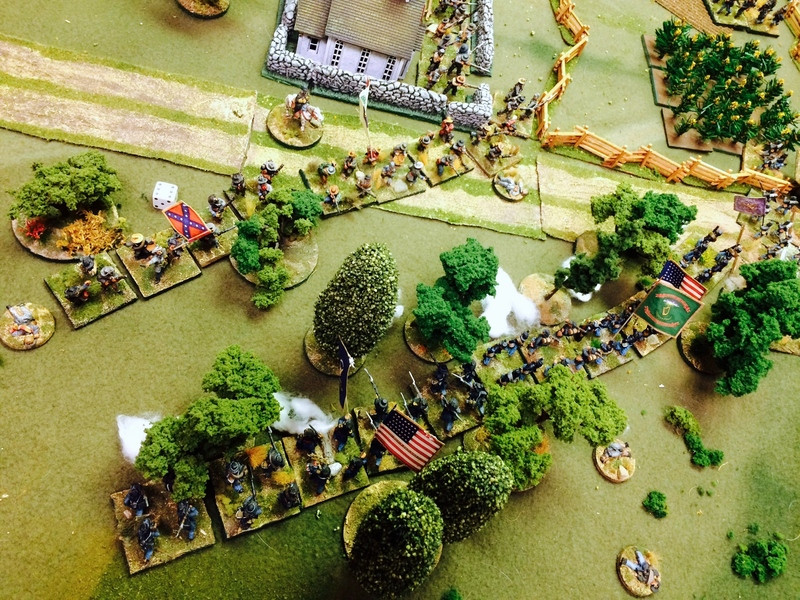
But, the CSA plays an interrupt card and negates the Union attack. Boo!
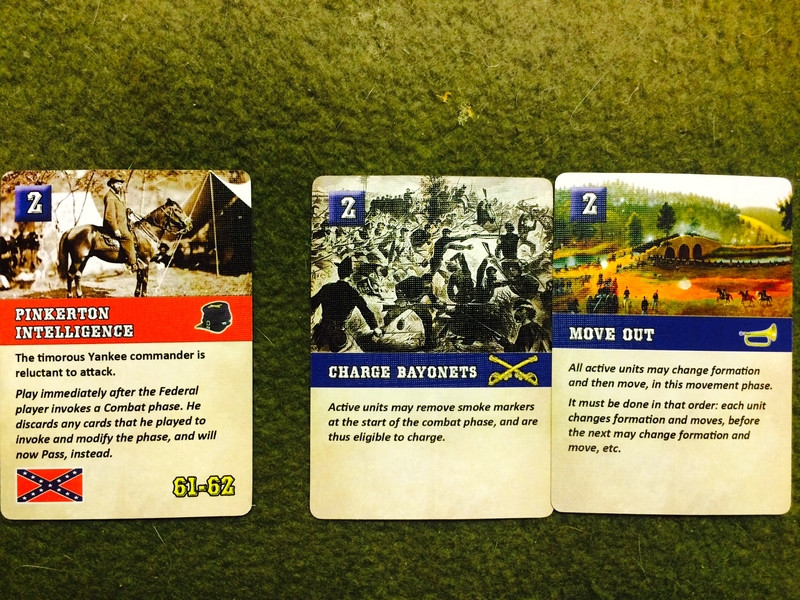
Union troops have to stand and take it while the Confederate reinforcements finally arrive and ride around the Wisconsin flank.
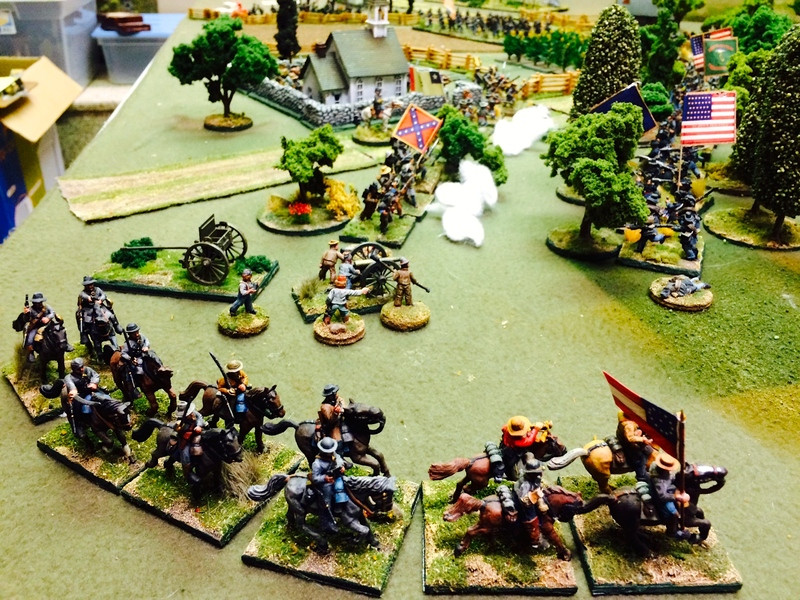
And keep riding. The 31st Wisconsin, having lost half its strength, falls back to keep from being flanked, while the 33rd Wisconsin decides the best thing to do is charge. It pushes the 42nd Mississippi back.
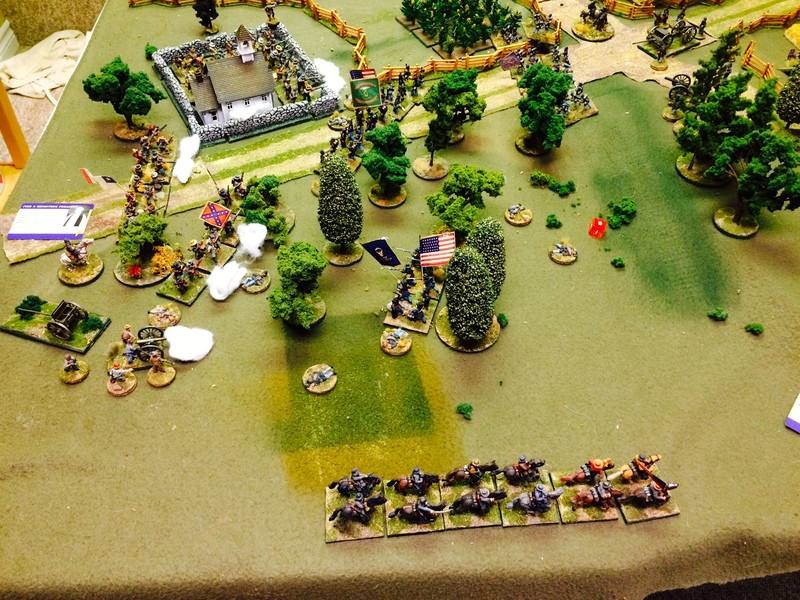
Only to take accurate fire from the 39th Mississippi holding Ebeenezer Church.
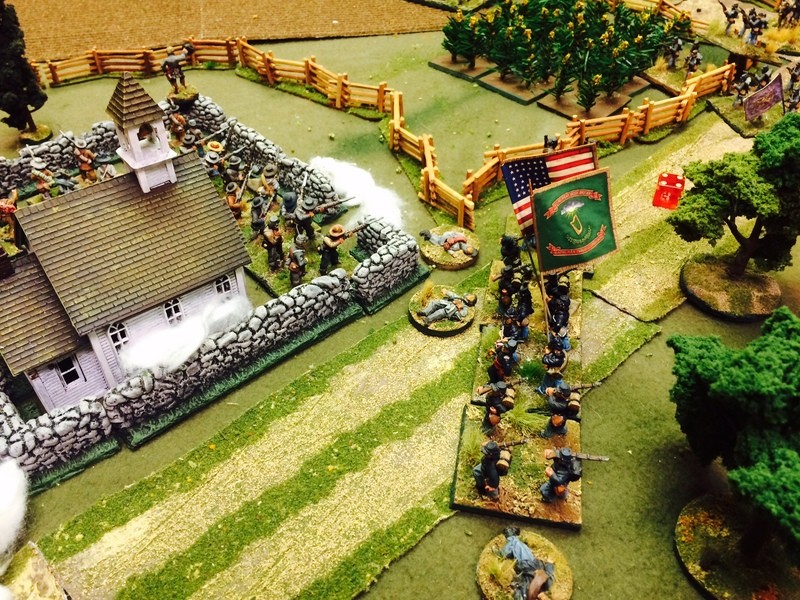
Things are not looking good for Schotz on his left. Canister fire from the LRA continues to shred the 31st Wisconsin.
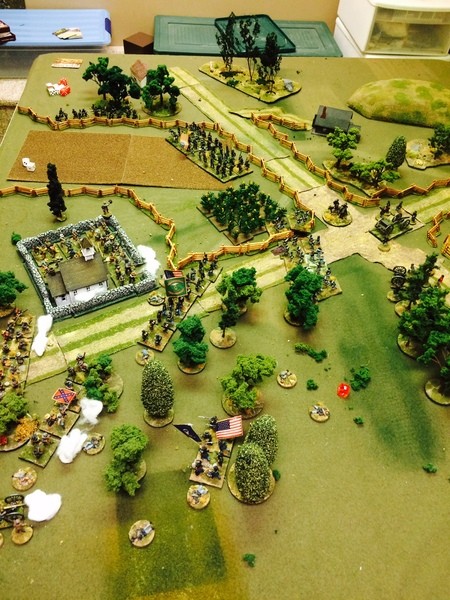
Union plays another interrupt card, Confusion, and moves the CSA cavalry further along the Union flank and out of harm’s way.
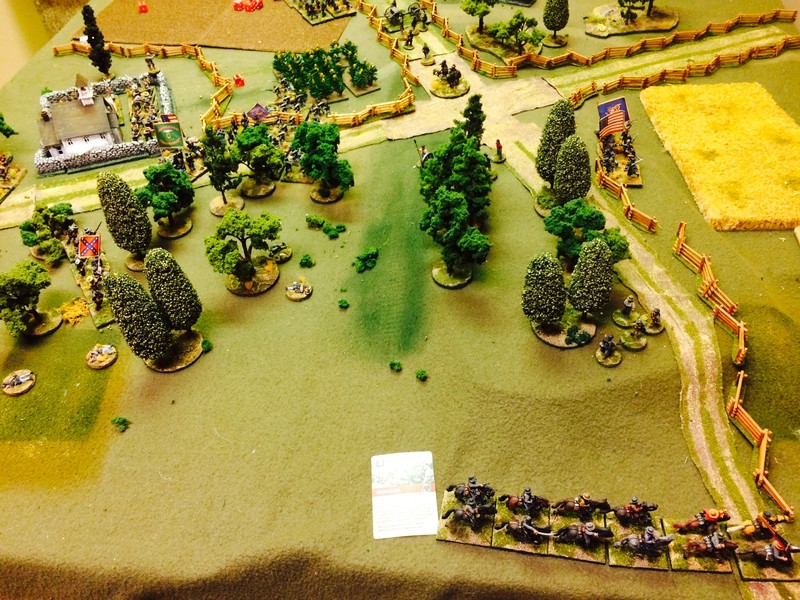
With time running out, Schotz throws his greenhorns of the 11th Ohio at the walls of the church in a gallant charge, but it’s not enough. The Union troops are thrown back. Schotz regretfully decides that his brigade has done all that can be done, and abandons further efforts to capture the church.
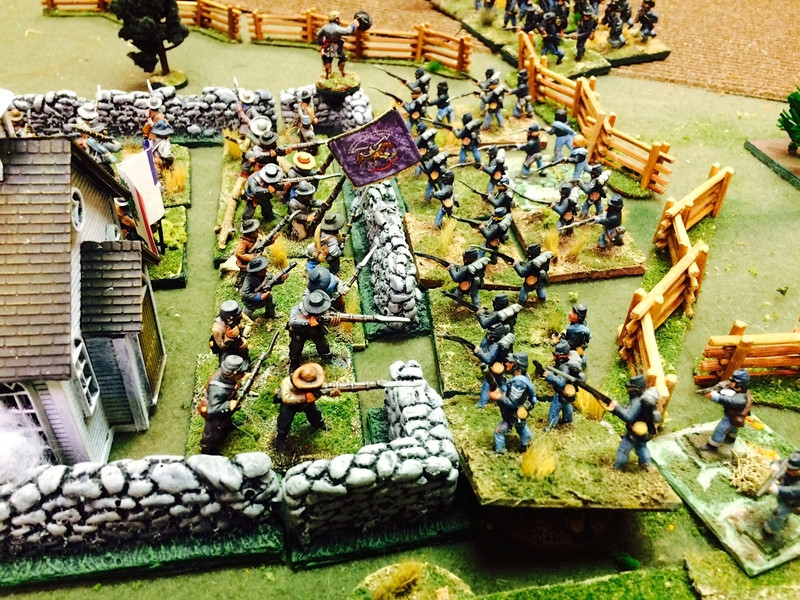
Schotz has now fought two battles since the war began, and has lost both. His attacks on the church were largely uncoordinated, and he failed to use his supporting artillery to best effect. Two of his regiments failed to get into the fight at all, and his veterans suffered badly.
In the following months, his brigade rests and refits. Using the Longstreet campaign rules, the brigade now looks like this.
31st Wisconsin, Seasoned Veterans, 5 stands
32nd Wisconsin - disbanded and merged with the 31st and 33rd.
33rd Wisconsin - Seasoned Veterans, 5 stands. The 33rd gets the benefit of now being considered Old Reliables, and is immune to the Confusion and Old Rivals interrupt cards in future battles.
5th Kansas Cavalry - Eager Recruits, 5 stands
9th Wisconsin Volunteer Artillery gets reinforced and now fields 2 stands howitzers and 2 stands Light Rifles
11th Ohio (much stricken with fever) 5 stands Eager Recruits
23rd Michigan (same) 6 stands Eager Recruits
Finally to bring the brigade up to the requisite 40 stands, the brigade gets 14 stands of reinforcements:
51st Ohio Eager Recruits, 5 stands
42nd Wisconsin, Eager Recruits, 8 stands
While few are left of the original volunteers from German and Irish Milwaukee, the brigade is ready for future battles to preserve the Union and end succession.
Blessings to your die rolls!
MP+
Monday, October 19, 2015
Longstreet, Seizing Ebeneezer, Part Two
Quick update tonight on my ongoing Longsteet solo game, the Union attempt to seize Ebeneezer Church. To recap, end of Turn 1, Union attack starts to develop.
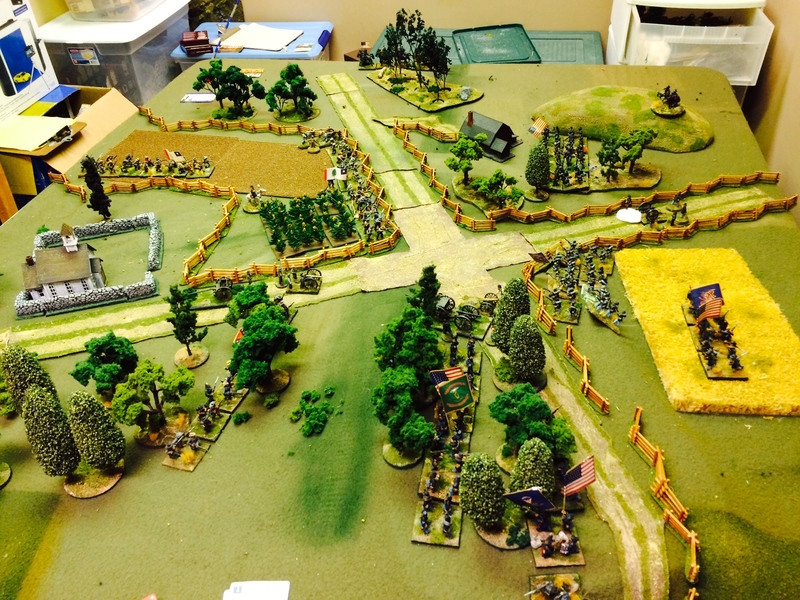
Engel’s 9th Wisconsin Vol. Artillery gets two of its sections on the hill overlooking the crossroads, a howitzer and a light rifle (note recently finished Perry Bros limber with invisible horses). The 11th Ohio surges up in support. Cannister fire from the Napoleon of the Little Rock Artillery destroys the howitzer before it can unlimber.
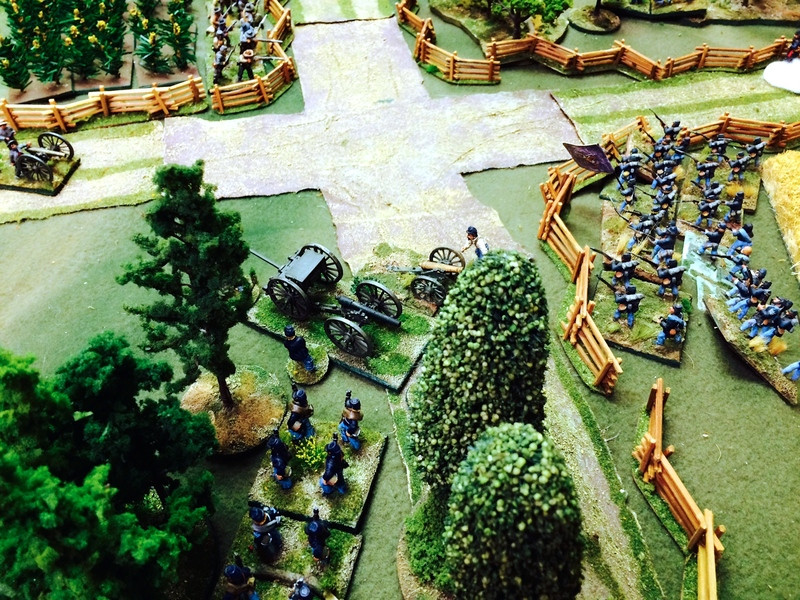
On the Union left, the Irish of the 33rd Wisconsin push forward to the woods where the 14th Arkansas greets them with a volley, special effects supplied by my amazing Kinch lights. The Union plays a Thick Smoke card turning the CSA shooting into Skirmish Fire (requiring a 6 on a d6 to hit) and the Arkansans miss.
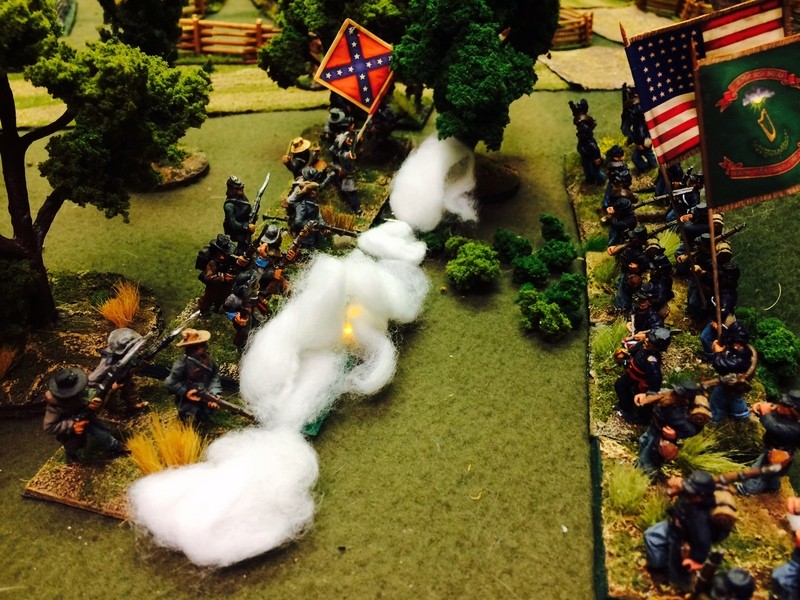
General Pinckney follows the advice of his Chief of Staff, Col. Frietag, and has the 39th Mississippi about face and retire from their advanced position. The reserve 42nd MS crosses from left to right to reinforce the 14th Ark. Unfortunately, the Union plays an interrupt card, freezing the 42nd MS in their tracks and creating a traffic jam. In the background, the other section of the Little Rock artillery, also moving from left to reinforce the right, gets jammed up as well.
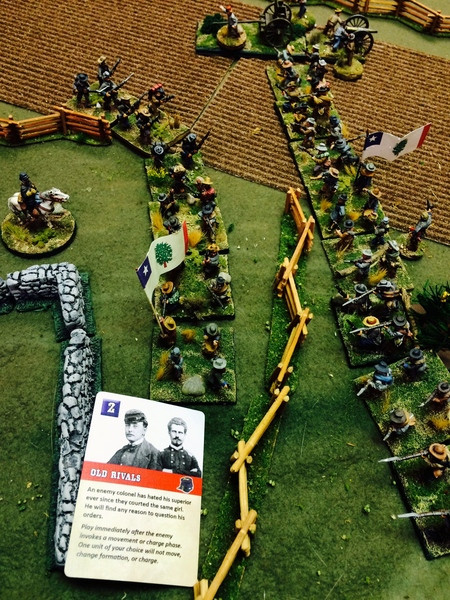
Overview of the battlefield at the end of the 3rd turn.
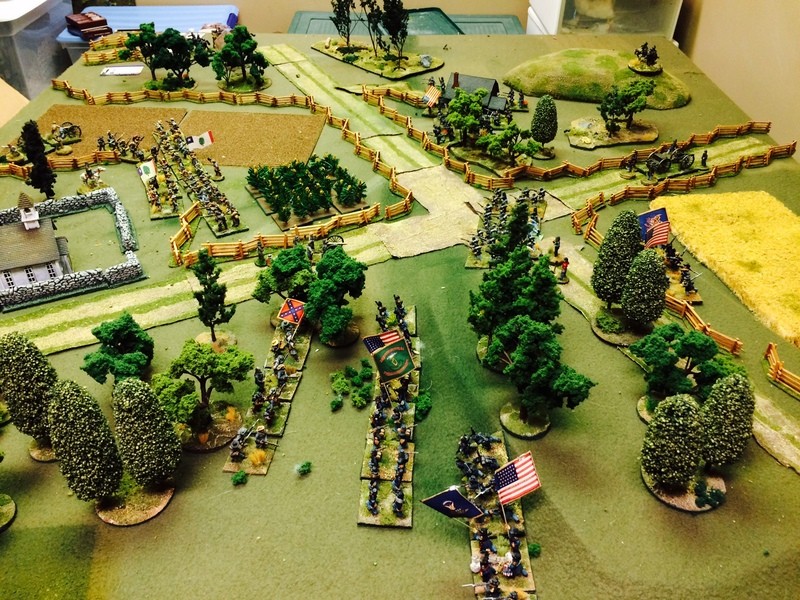
Union Turn Four. The 33rd WI returns fire at the 14th AR, but since the rebs are in the woods and it is thus skirmish fire, the Union miss the needed sixes. Lots of gun smoke but no damage.
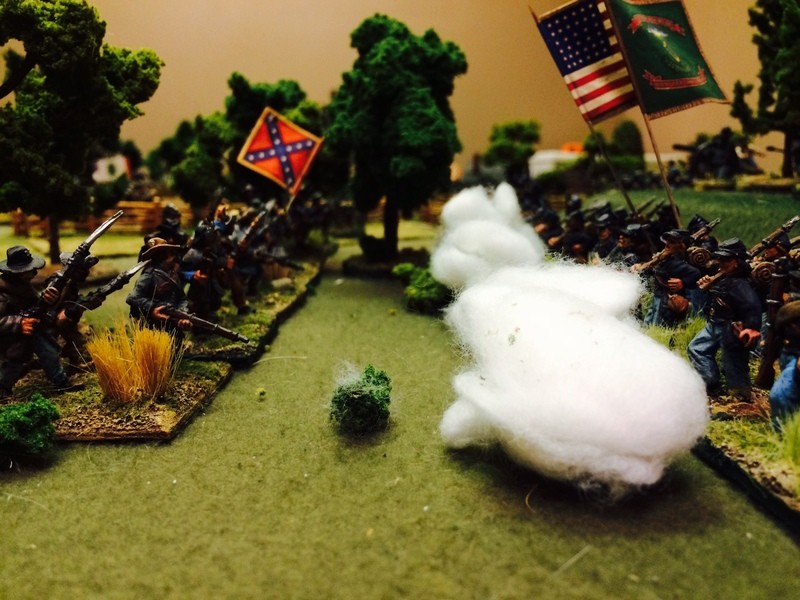
Union movement face, the 31st WI burns two cards to interpenetrate the 33rd and now threaten the 14th AR’s flank.
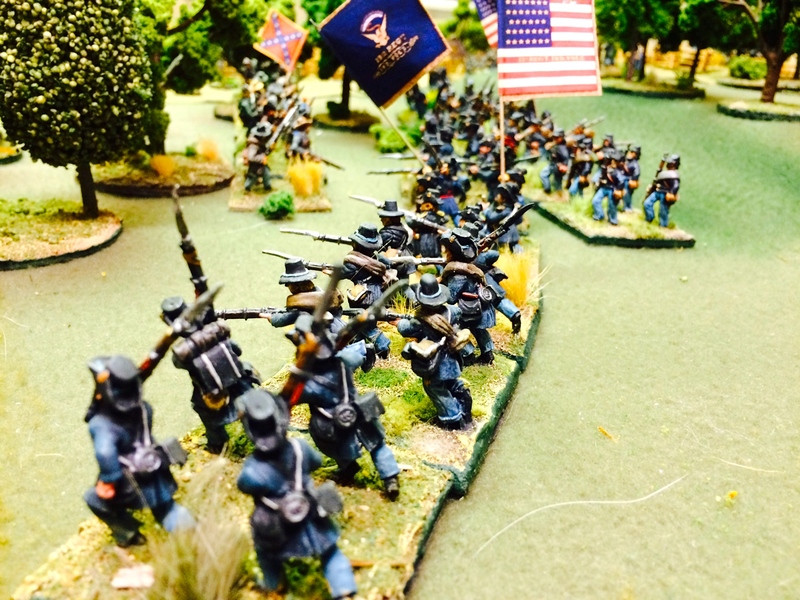
Situation at the beginning of the CSA turn. Note the Union cavalry have reached the other end of the table and are poised to dismount along the fence line. The rebs don’t have much time to sort themselves out.
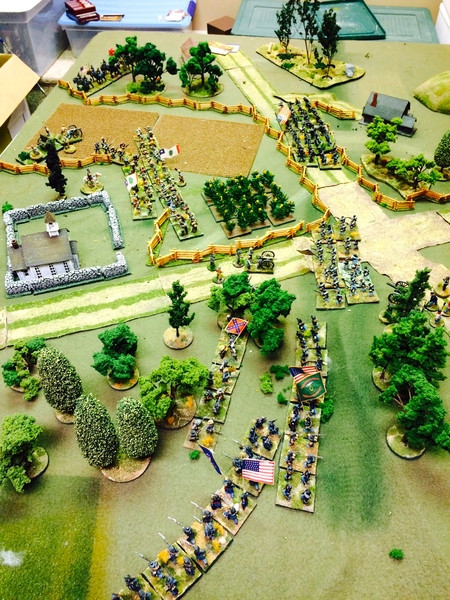
Advice for General Pinckney?
Blessings to your die rolls!
MP+








